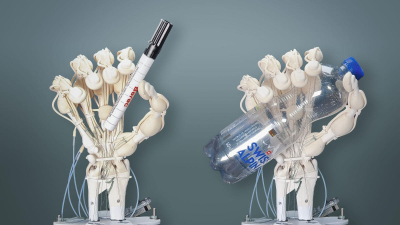
Researchers have succeeded in printing robotic hands with bones, ligaments and tendons for the first time. Using a new laser scanning technique, the new technology enables the use of different polymers.
Additive manufacturing or 3D printing is the construction of a 3D object from a 3D digital model. The technology behind this has been advancing at great pace and the number of materials that can be used have also expanded reasonably. Until now, 3D printing was limited to fast-curing plastics. The use of slow-curing plastics has now been made possible thanks to a technology developed by researchers at ETH Zurich and a MIT spin-off U.S. start-up, Inhabit. This has resulted in successfully 3D printing robotic hands with bones, ligaments and tendons. The researchers from Switzerland and the U.S. have jointly published the technology and their applications in the journal Nature.
Return to original state
In addition to their elastic properties that enable the creation of delicate structures and parts with cavities as required, the slow-curing thiolene polymers also return to their original state much faster after bending, making them ideal for the likes of ligaments in robotic hands.
The stiffness of thiolenes can also be fine-tuned as per our requirements to create soft robots. These soft robots will not only be better-suited to work with humans, but will also be more adept at handling delicate and fragile goods.
Scanning, not scraping
In 3D printers, objects are typically produced layer by layer. This means that a nozzle deposits a given material in viscous form and a UV lamp then cures each layer immediately. This method requires a device that scrapes off surface irregularities after each curing step.
While this works for fast-curing plastics, it would fail with slow-curing polymers like thiolenes and epoxies as they would merely gum up the scraper. The researchers involved therefore developed a 3D printing technology that took into account the unevenness when printing the next layer, rather than smoothing out uneven layers. They achieved this using a 3D laser scanner that checked each printed layer for irregularities immediately.
This advancement in 3D printing technology would provide much-needed advantages as the resulting objects not only have better elastic properties, but are also more robust and durable. Combining soft, elastic, and rigid materials would also become much more simpler with this technology.
Picture Credit : Google




